|
On the night of August 20 - August 21, 1968, the Soviet Union and four of its Warsaw Pact allies invaded the Czechoslovak Socialist Republic in order to halt Alexander Dubček's Prague Spring political liberalization reforms. In the operation, codenamed Danube, varying estimates of between 175,000 and 500,000 troops attacked Czechoslovakia. 108 Czechoslovaks died and approximately 500 were wounded as a direct result of the invasion. The operation successfully stopped liberalization reforms and strengthened the authority of the Communist Party of Czechoslovakia.
A young photographer had started taking commissions from theatre magazines, and regularly photographed stage productions at Prague's 'Theatre Behind the Gate' on an old Rolleiflex camera. In 1967, he decided to give up his career in engineering for full-time work as a photographer. He had returned from a project shooting gypsies in Romania just two days before the Soviet invasion, in August 1968.
He witnessed and recorded the military forces of the Warsaw Pact as they invaded Prague and crushed the Czech reforms.
His negatives were smuggled out of Prague into the hands of the Magnum agency, and published anonymously in The Sunday Times Magazine under the initials P. P. (Prague Photographer) for fear of reprisal to him and his family. His pictures of the events became dramatic international symbols.
In 1969 the "anonymous Czech photographer" Josef Koudelka, was awarded the Overseas Press Club's Robert Capa Gold Medal for photographs requiring exceptional courage.
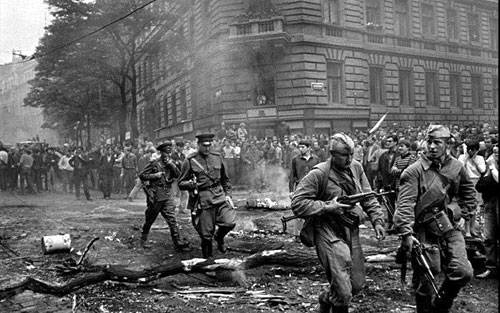
Born in Monrovia, Czechoslovakia in 1938, Josef Koudelka began photographing his family and surroundings as a teenager with a 6 x 6 Bakelite camera.
He was trained at the Technical University in Prague and worked as an aeronautical engineer in Prague and Bratislava from 1961-67. He had been able to obtain an old Rolleiflex and in 1961 started a detailed study of the gypsies of Slovakia, who were then undergoing further attempts to "assimilate" them within the Czech state. At first, Koudelka was attracted by the physical beauty of the Gypsies of Eastern Europe, the strangeness of their movements and their facial expression, by their clothing and ornaments; later he was attracted by their life-style. In the end he was completely absorbed by his subject.
He developed a great feeling for the Gypsies; drawn to them, he sought to learn the origin of those things which first attracted him. He worked constantly to get to know them better, in depth, in order to establish profound contacts and devoted himself to his subject with burning intensity.
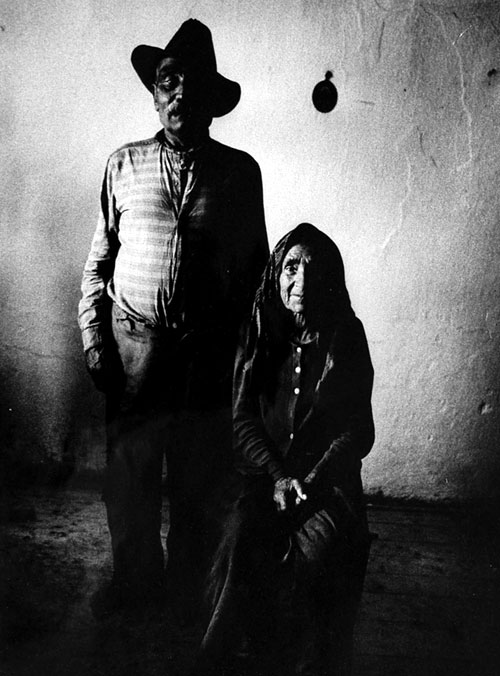
Koudelka achieves restraint and clarity, and a respect for human beings. His work reflects a long evolution of his vision from the external to the inherent and ultimate nature of his subjects. His work was the subject of an exhibition in Prague in 1967.
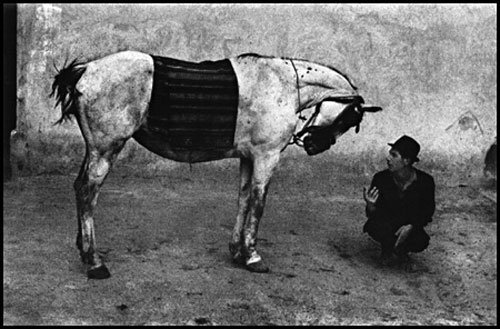
In 1968 Koudelka extended his project to gypsy communities in Rumania and that same year recorded the invasion of Prague by Warsaw Pact armies.
In 1969, a year after Russian tanks rolled into Prague, Josef Koudelka visited London with a Czech theatre group. One Sunday morning he was walking out of his hotel near the Aldwych Theatre when he saw some members of the theatre group perusing a copy of the Sunday Times magazine. As he passed, he saw to his surprise that they were looking at his own extraordinary photographs of that Russian invasion and the spontaneous street protests it provoked. The same photos have since become the definitive pictorial record of a pivotal event in 20th century history.
'They showed me the magazine where it said that these pictures had been taken by an unknown photographer from Prague and smuggled out of the country,' he says, shaking his head as if he still cannot believe it. 'I could not tell anyone that they were my photographs. It was a very strange feeling. From that moment, I was afraid to go back to Czechoslovakia because I knew that if they wanted to find out who the unknown photographer was, they could do it.'
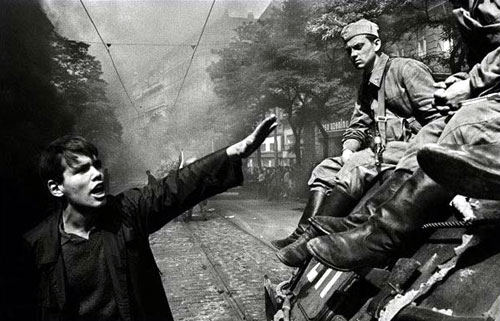
In 1970 Koudelka left Czechoslovakia and, officially stateless, was awarded asylum in England. Introduced to Magnum by Elliott Erwitt, he became an associate in 1971 and a member in 1974, but still refused most journalistic assignments: in constant movement, he preferred to wander around Europe in search of pictures of a world that he felt was rapidly disappearing, Koudelka has been the recipient of major grants and awards such as the Prix Nadar (1978), the Grant for Research Abroad, and an official invitation from the French Ministry to document urban and rural landscape in France (1986), as well as a Grand Prix National de la Photographie (1989) and a Grand Prix Cartier-Bresson (1991). The grants sustained him through long-term projects in black and white which led to many exhibitions and the publication of several books following Gypsies (1978) such as Exiles (1988) shot at the edges of Europe in Ireland, Spain, Portugal and Greece.
Koudelka has returned to Prague from his adopted home in Paris for an exhibition of his '68 photographs that was being held in the Old Town Hall to coincide with the 40th anniversary of the invasion. A book called Invasion Prague 1968* was published earlier this year, an extraordinary chronicle of those convulsive seven days when the people of Prague, young and old, took to the streets in their thousands to protest at the Russian presence.
'For a long time no one here was interested in remembering,' says Koudelka, 'but now I think they start to remember again. If this book helps the remembering I am happy. We Czechs are not like you Irish or the Poles. We do not behave bravely many times against the odds, but in this one week, as my book shows, we should be very proud of how we behave.'
In that one week, the 30-year-old Koudelka took over 5,000 photographs on the streets of Prague, often under extreme conditions. He was shot at by a Russian soldier, and pursued through the crowds and into the backstreets around Wenceslas Square. In the short film that ends the exhibition, a young and scrawny Koudelka is seen perched on a Russian tank, filming a young Czech man waving a flag of resistance. Some of the people in the photographs turned up for the opening of the show, including a man whose arm Koudelka had positioned in the foreground of an empty Prague street, the watch on his wrist telling the time of the invasion. 'Forty years have gone by,' says Koudelka, 'and I do not remember them nor they me. You cannot rely on your memories - but you can rely on your pictures.'
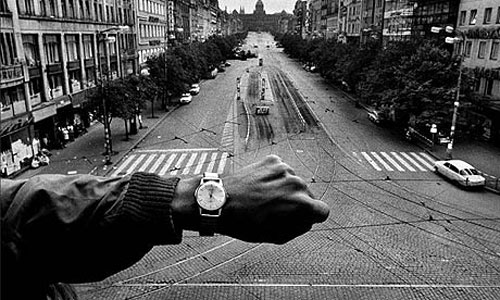
Presenting around 300 works by Koudelka from various periods, this Retrospective, organised by Benaki Museum in Athens in co-operation with the photographic agencies Magnum Photos and Apeirongives, offers to the audience the opportunity to get a good insight on the contemporary master of photography.
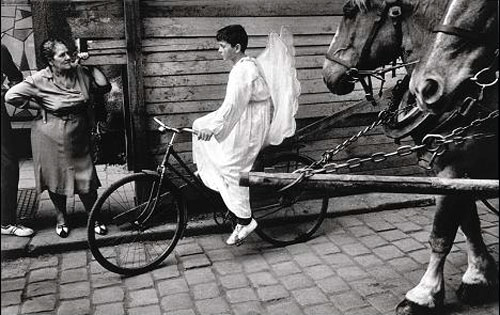
The exhibition commences with the chapters "The Beginning" and "The Quest" that feature original prints from the late 1950s to early 1960s and two parallel thematic units, namely the "Gypsies" and Koudelka's photographs from his work in theatre performances. The unit "The Invasion" presents one of Koudelka's major works, his photos from Prague on August 1968. The following thematic unit "Exiles" depicts the feeling of exile, the artist himself experienced in the period 1970 - 1990, as a result of his own decision to live in exile. The exhibition concludes with the unit entitled "Chaos", which features a series of panoramic photos depicting the irreversible damage on natural environment.
The exhibition forms part of the events taking place on the occasion of the French Presidency of the EU and is being realised with the support of the French Embassy in Greece, the Czech Republic and the French Institute of Athens . 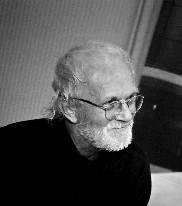
* Invasion Prague 1968 is published by Thames & Hudson
All Images © Josef Koudelka / Magnum Photos
|


